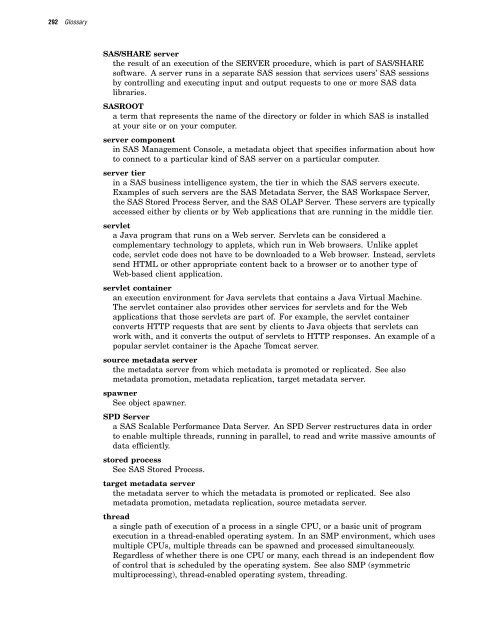SAS 9.1.3 Intelligence Platform: System Administration Guide
SAS 9.1.3 Intelligence Platform: System Administration Guide
SAS 9.1.3 Intelligence Platform: System Administration Guide
Create successful ePaper yourself
Turn your PDF publications into a flip-book with our unique Google optimized e-Paper software.
292 Glossary<br />
<strong>SAS</strong>/SHARE server<br />
the result of an execution of the SERVER procedure, which is part of <strong>SAS</strong>/SHARE<br />
software. A server runs in a separate <strong>SAS</strong> session that services users’ <strong>SAS</strong> sessions<br />
by controlling and executing input and output requests to one or more <strong>SAS</strong> data<br />
libraries.<br />
<strong>SAS</strong>ROOT<br />
a term that represents the name of the directory or folder in which <strong>SAS</strong> is installed<br />
at your site or on your computer.<br />
server component<br />
in <strong>SAS</strong> Management Console, a metadata object that specifies information about how<br />
to connect to a particular kind of <strong>SAS</strong> server on a particular computer.<br />
server tier<br />
in a <strong>SAS</strong> business intelligence system, the tier in which the <strong>SAS</strong> servers execute.<br />
Examples of such servers are the <strong>SAS</strong> Metadata Server, the <strong>SAS</strong> Workspace Server,<br />
the <strong>SAS</strong> Stored Process Server, and the <strong>SAS</strong> OLAP Server. These servers are typically<br />
accessed either by clients or by Web applications that are running in the middle tier.<br />
servlet<br />
a Java program that runs on a Web server. Servlets can be considered a<br />
complementary technology to applets, which run in Web browsers. Unlike applet<br />
code, servlet code does not have to be downloaded to a Web browser. Instead, servlets<br />
send HTML or other appropriate content back to a browser or to another type of<br />
Web-based client application.<br />
servlet container<br />
an execution environment for Java servlets that contains a Java Virtual Machine.<br />
The servlet container also provides other services for servlets and for the Web<br />
applications that those servlets are part of. For example, the servlet container<br />
converts HTTP requests that are sent by clients to Java objects that servlets can<br />
work with, and it converts the output of servlets to HTTP responses. An example of a<br />
popular servlet container is the Apache Tomcat server.<br />
source metadata server<br />
the metadata server from which metadata is promoted or replicated. See also<br />
metadata promotion, metadata replication, target metadata server.<br />
spawner<br />
See object spawner.<br />
SPD Server<br />
a <strong>SAS</strong> Scalable Performance Data Server. An SPD Server restructures data in order<br />
to enable multiple threads, running in parallel, to read and write massive amounts of<br />
data efficiently.<br />
stored process<br />
See <strong>SAS</strong> Stored Process.<br />
target metadata server<br />
the metadata server to which the metadata is promoted or replicated. See also<br />
metadata promotion, metadata replication, source metadata server.<br />
thread<br />
a single path of execution of a process in a single CPU, or a basic unit of program<br />
execution in a thread-enabled operating system. In an SMP environment, which uses<br />
multiple CPUs, multiple threads can be spawned and processed simultaneously.<br />
Regardless of whether there is one CPU or many, each thread is an independent flow<br />
of control that is scheduled by the operating system. See also SMP (symmetric<br />
multiprocessing), thread-enabled operating system, threading.
















